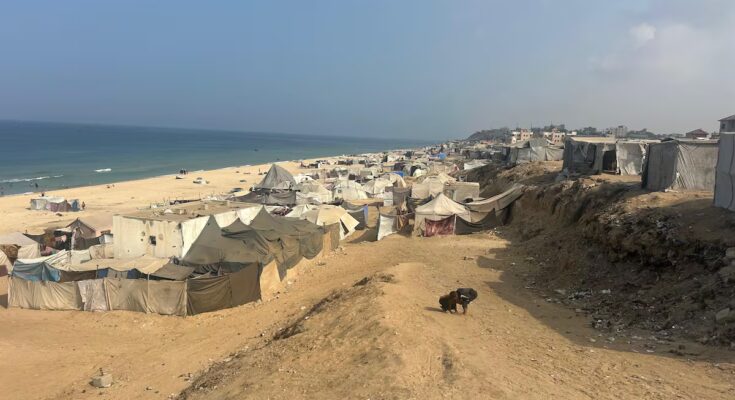Masoud al-Yamani, 42, tries to rope a fragile plastic and fabric structure and the remains of his destroyed home in Khan Younis, in the southern Gaza Strip, so it can withstand the wind. Six months ago I was living on the west side of town. He had to move, risked dying in a bombing and finally returned to live in the ruins of what was his home. His four children, the youngest just three years old, collect pieces of wood from the rubble of nearby buildings. The dust of destruction constantly hangs in the air.
“Are you asking me about preparations for the winter?” he says, mixing anger and sarcasm. “Do you see this devastation? We have nothing. I didn’t get a tent, I didn’t get blankets, I don’t have warm clothes or money to buy them. Most of us in Gaza face the cold completely without protection,” he says.
In Gaza it began to rain on Thursday and flooded dozens of precarious tents where people sleep on the ground, at best on mattresses. Displaced families are wondering what the next few months have in store for them, without shelter to protect them and exposed to the ravages of the sea, located just meters away. Despite the UN and humanitarian organizations trying to accelerate the entry of material to protect the population, the volumes that Israel authorizes to enter the Strip continue to be lower than the real needs of the population.
In the Nuseirat refugee camp in central Gaza, Shahrazad Siyam, 39, cradles her youngest daughter, Siwar, aged two years and two months. The girl trembles against his chest, coughs incessantly and has a swollen throat from an acute respiratory infection. “We have no tent, blankets, warm clothes. We have nothing. We practically live outdoors, on the beach. My children shiver all night and I try to calm them by reading the Koran to them. What else can I do?” says Siyam, a mother of four children, the oldest of whom is 11 years old.
“Preparing for winter? How do those who live outdoors prepare?” this woman asks, her voice trembling with anger. “Did we survive the bombing only to succumb to the cold, water and rain?” this early childhood educator asks as she administers a spoonful of the drug to her daughter every two hours, even though the instructions say she must wait eight hours between doses. “The medicine doesn’t work and I have no choice. I have to try,” he explains.
Every time I look at the sea, I have nightmares. I dream that the waves rise, that we drown, that no one hears our screams and we die in silence
Riad Siyam, displaced person from Gaza
The woman, who had to move with her family from Gaza City three months ago, is tired and distraught. Her husband Riad, 40, explains that there are no latrines near their tent and that the children have to go out in the middle of the night and expose themselves to the cold to go to a neighbor. This family man lost his source of income when Israel destroyed his wagon and killed his donkey in an artillery attack shortly after the offensive against Gaza began. “Every time I look at the sea, I have nightmares. I dream that the waves rise, that we drown, that no one hears our screams and we die in silence,” he says fearfully.
Completely unprotected
According to the UN, 1.48 million Gazans, out of a total population of around two million, are in urgent need of shelter or decent housing and more than 320,000 homes have been totally or partially destroyed in two years of bombing.
Israel and Hamas agreed to a ceasefire a month ago, but the Israeli army continues to militarily occupy more than half of the Strip and humanitarian aid entering the territory is insufficient.
US President Donald Trump’s plan for Gaza, which served as the basis for negotiating the truce between Hamas and Israel, called for the entry and distribution of humanitarian aid into Gaza, at a level similar to that recorded in the two-month ceasefire earlier this year, when the daily flow ranged between 500 and 600 trucks. Humanitarian organizations say the actual volume of aid arriving in the Palestinian territories in recent weeks has been lower. According to COGAT, the Israeli organization in charge of coordinating, among others, the entry of humanitarian aid into Gaza, “hundreds of trucks with food, medicines and materials to provide shelter to the population enter the Strip every day.”
Mahmoud Omar, a humanitarian worker in the Al Mawasi area in the south, where many of the displaced people of the Strip are concentrated, receives hundreds of requests every day from families asking for tents, blankets, clothes and other basic necessities.
“What I can provide through the organizations that help us is nothing compared to the need,” he says. “The tents in the camps are broken or torn. People have no way to prepare for the winter because they can’t buy anything, they have no money and they haven’t even received help.”
“Last winter, the destruction was less. Many displaced people managed to return to what was left of their homes. Now, in some places, the destruction is approaching 100%,” he laments.
Last winter there was less destruction. Many displaced people were able to return to what remained of their homes. Now, in some places, destruction approaches 100%
Mahmud Omar, humanitarian worker
Amjad al Shawa, director of the Network of Palestinian Civil Society Organizations, estimates that 300,000 new tents are needed, but they have only managed to bring in around 5,000 tents and 85,000 tarpaulins since the ceasefire took effect, according to UN data. COGAT says a total of 90,000 tents and tarpaulins have entered Gaza “in recent months.”
Humanitarian aid enters through the Kerem Shalom and Kissufim border crossings, and on Wednesday Israel allowed the reopening of the Zikim crossing in the north.
Al Shawa fears that the rains will cause the wells to overflow, collapse the sanitation infrastructure, which is already badly damaged, and spread diseases among the most vulnerable populations such as children, the elderly and the sick.
“The health system is already collapsing. How will we respond when winter arrives and diseases spread?” asks the expert, recalling that local and international humanitarian organizations have developed a plan to face the winter that they cannot put into practice due to lack of material means.
Their requests range from the withdrawal of the Israeli military from large areas of Gaza to reduce overcrowding, to the arrival of clothes or blankets, to the arrival of material to remove debris.
The hardest winter
Aid workers are also calling for aid from UNRWA, the United Nations agency for Palestinian refugees, to be allowed to enter Gaza’s gates. Israel does not allow this organization, present in the Strip for decades and where it provides education and healthcare to tens of thousands of people, to continue working in Gaza and accuses it of being linked to the attacks by the Islamist movement Hamas on 7 October 2023. “We have food for 1.1 million people, flour for 2.1 million people and shelter supplies for up to 1.3 million people,” the organization said in recent days.
If someone does not help us quickly, our fate will be catastrophic. The sea could sweep us away. In the best case scenario, the cold will kill us all, large and small
Shahrazad Siyam, mother of a family from Gaza
“This will be the harshest winter ever recorded in Gaza, despite the ceasefire, because the level of destruction, forced displacement and hunger is greater than ever,” estimates Al Shawa. “If any trace of humanitarian conscience remains in the world, cold, rain and disease will not be allowed to kill the people of Gaza,” he adds.
Back on Nuseirat beach, Shahrazad Siyam holds Siwar, who has finally fallen asleep after hours of constant coughing. The mother cannot find hope again. “If someone doesn’t help us quickly, our fate will be catastrophic,” he says, his voice cracking. “The sea could sweep us away. At best, the cold will kill us all, big and small.”



